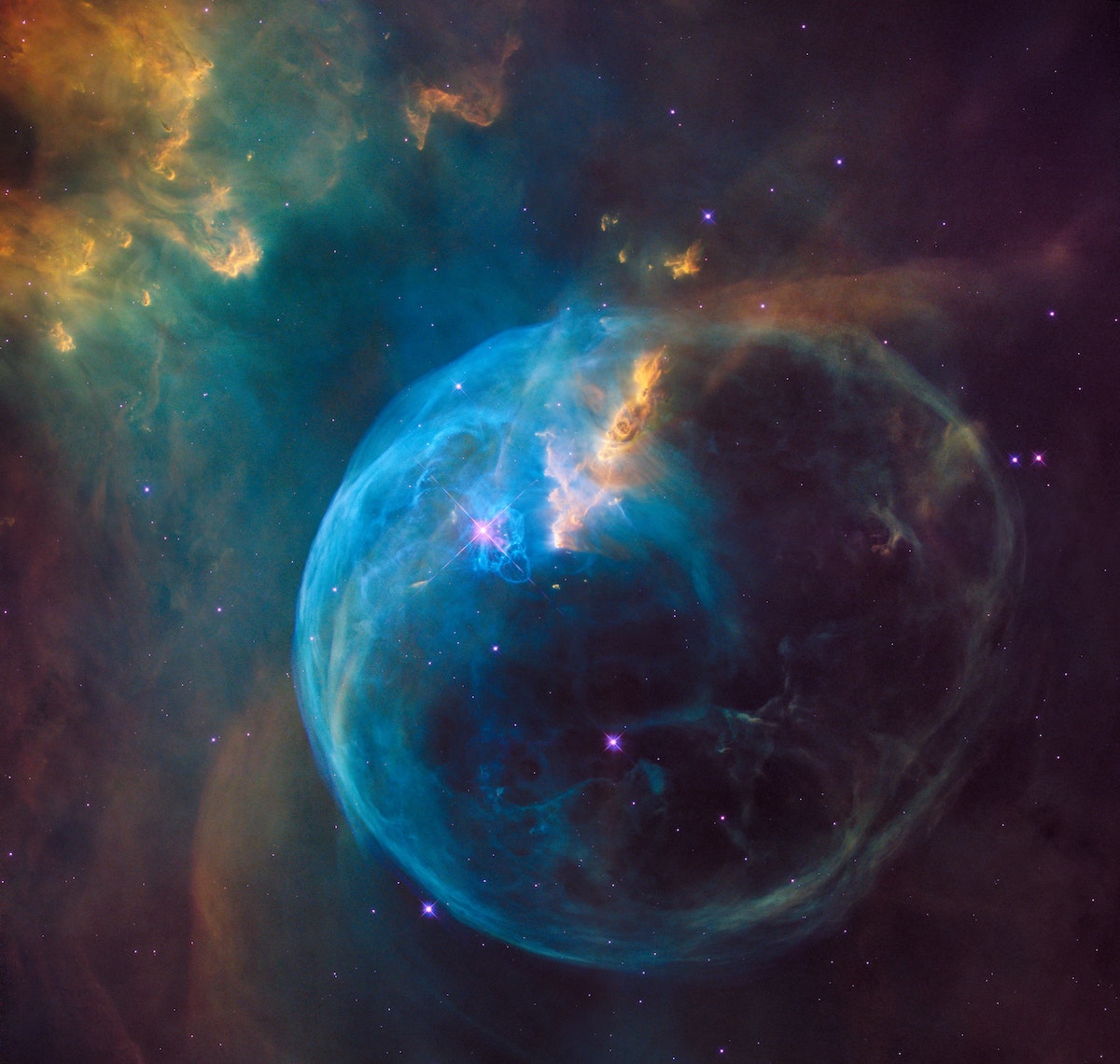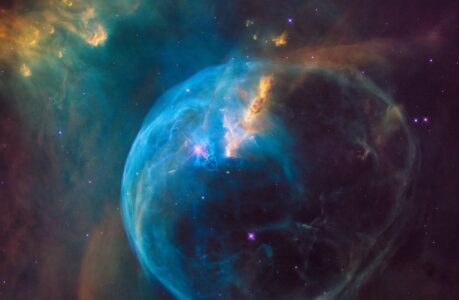The Bubble Nebula (NGC 7635) is a spectacular cosmic wonder located in the constellation Cassiopeia, about 7,100 light-years away from Earth. It is a diffuse nebula, a type of emission nebula that is illuminated by the light of nearby stars. The nebula was discovered in 1787 by William Herschel, and since then it has been a popular target for astronomers and stargazers alike.
One of the most striking features of the Bubble Nebula is its bubble-like appearance, which is caused by a massive star at its centre. This star, known as BD+602522, is estimated to be about ten times more massive than our Sun and is emitting a strong stellar wind that creates a cavity in the surrounding gas and dust. The bubble-shaped structure is the result of the expansion of the cavity, which is pushing the gas and dust away from the star.
The Bubble Nebula is also home to other fascinating features, such as the finger-like protrusions of gas and dust that extend from the bubble’s surface. These protrusions are created by the strong radiation and stellar wind from the central star interacting with the surrounding material. The nebula also contains several dark nebulae, areas of gas and dust that are so dense that they block the light from background stars.
Observing the Bubble Nebula from Earth can be a rewarding experience for amateur astronomers. The nebula can be spotted with a small telescope or even a pair of binoculars, but it is best observed with a larger telescope under dark skies. To locate the Bubble Nebula, look for the constellation Cassiopeia in the northern sky. The nebula is located near the star cluster M52 and appears as a faint, circular patch of light.
Capturing stunning images of the Bubble Nebula requires specialised equipment, such as a camera capable of capturing long-exposure images and a telescope with a large aperture. With the right equipment and technique, astrophotographers can capture breathtaking images of the nebula’s intricate details and vivid colours.
Diffuse nebula
A diffuse nebula is a type of interstellar cloud that is composed of gas and dust spread out over a large area. These clouds are mainly composed of hydrogen gas and are illuminated by nearby stars, causing them to glow brightly in visible light.
Diffuse nebulae are classified based on their appearance and the type of radiation they emit. The two main types of diffuse nebulae are emission nebulae and reflection nebulae.
Emission nebulae are clouds of gas that emit their own light, mainly in the red part of the spectrum. They are typically ionised by ultraviolet radiation from nearby hot stars, which strips electrons from the atoms in the gas cloud, causing them to emit light.
One of the most famous examples of an emission nebula is the Orion Nebula (M42), which is located in the constellation Orion and is visible to the naked eye. The Orion Nebula is one of the brightest and most massive diffuse nebulae in the sky and is a popular target for astronomers and astrophotographers.
Reflection nebulae, on the other hand, do not emit their own light but instead reflect the light from nearby stars. They are typically composed of small dust particles that scatter light, giving them a bluish appearance.
The Pleiades (M45) star cluster is a well-known example of a reflection nebula. The bright blue stars in the cluster illuminate the surrounding gas and dust, causing it to scatter blue light and creating a stunning visual effect.
Diffuse nebulae play an important role in the formation and evolution of stars. They are the birthplaces of new stars, as the gas and dust in the cloud collapse under their own gravity to form protostars. The intense radiation from these newly formed stars can also trigger the formation of new stars in nearby clouds, leading to the creation of star clusters and stellar associations.
In conclusion, diffuse nebulae are beautiful and fascinating celestial objects that play a crucial role in the life cycle of stars. Their unique properties and stunning appearance make them a popular target for observation and astrophotography, and studying them can deepen our understanding of the universe and its evolution.
BD+602522
BD+602522 is a massive star located at the centre of the Bubble Nebula (NGC 7635), a celestial object located in the constellation Cassiopeia, about 7,100 light-years away from Earth. The star is estimated to have a mass of about ten times that of our Sun and is the primary source of the strong stellar wind that is responsible for creating the bubble-like shape of the nebula.
The intense radiation and high temperatures produced by BD+602522 generate a large amount of energetic particles, which interact with the surrounding gas and dust in the nebula to create complex structures and features. These include the finger-like protrusions of gas and dust that extend from the surface of the bubble, as well as several dark nebulae that are visible against the bright background of the nebula.
BD+602522 is also a member of a class of stars known as Wolf-Rayet stars, which are massive, hot stars that are nearing the end of their lives. These stars are known for their intense stellar winds and their tendency to shed mass rapidly, which can lead to the formation of planetary nebulae and other complex structures.
The study of BD+602522 and other Wolf-Rayet stars is therefore important for understanding the evolution of massive stars and the role they play in shaping the interstellar medium. By studying the properties of these stars and their surrounding nebulae, astronomers can gain insights into the complex physical processes that govern the behaviour of stars and their interactions with their surroundings, and can deepen our understanding of the life cycle of stars and the evolution of the universe as a whole.
Stellar wind
Stellar wind refers to the flow of charged particles, such as protons and electrons, that is continuously emitted by stars, including our own Sun. The stellar wind originates from the outermost layer of a star’s atmosphere, known as the corona, and can travel at speeds of hundreds of kilometres per second.
The strength and composition of a star’s wind depend on several factors, including its mass, age, and activity level. Massive stars, for example, have much stronger winds than smaller stars, as the intense radiation and high temperatures in their cores generate a larger amount of energetic particles. Similarly, young stars and those that are highly active, such as those with strong magnetic fields, tend to have stronger winds than older, less active stars.
Stellar winds play an important role in shaping the surrounding interstellar medium, which is the gas and dust that exists between stars. As the charged particles in the wind interact with the interstellar medium, they can create shock waves and ionise the gas, leading to the formation of ionised nebulae, such as emission nebulae and planetary nebulae.
Stellar winds can also have a significant impact on the planets and other objects in a star’s solar system. For example, the solar wind from our own Sun can cause the auroras seen at the Earth’s poles and can affect the behaviour of spacecraft and satellites in orbit around the Earth.
In addition, the strong stellar winds from massive stars can have a profound effect on the evolution of their host galaxies. The energetic particles in the wind can heat up and ionise the interstellar gas, causing it to expand and escape the gravitational pull of the galaxy. This process, known as galactic superwinds, can drive the chemical enrichment of the intergalactic medium and regulate star formation in the galaxy.
Overall, stellar wind is a fundamental aspect of the life cycle of stars and plays a critical role in shaping the structure and evolution of the universe as a whole. The study of stellar winds is therefore an important area of research in astronomy, helping us to understand the complex processes that govern the behaviour of stars and their interactions with their surroundings.
In conclusion, the Bubble Nebula (NGC 7635) is a magnificent cosmic wonder that captivates astronomers and stargazers alike. Its unique features and stunning appearance make it a popular target for observation and astrophotography. Whether you’re a seasoned astronomer or a beginner, exploring the Bubble Nebula is a rewarding experience that can deepen your appreciation for the beauty of the universe.

